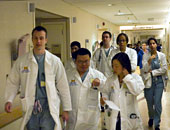ALERT!
This site is not optimized for Internet Explorer 8 (or older).
Please upgrade to a newer version of Internet Explorer or use an alternate browser such as Chrome or Firefox.
University of Michigan

University of Michigan
Cardiovascular Center
1500 E. Medical Center Drive
Ann Arbor, MI 48109-5852
Janice W. Davis, Program Coordinator
Andrew Chang, MD
Program Director
Head, Section of Thoracic Surgery
Department of Surgery
Richard Prager, MD
Associate Program Director
Head, Section of Adult Cardiac Surgery
Department of Cardiac Surgery
Richard Ohye, MD
Head, Section of Pediatric Cardiovascular Surgery
Department of Cardiac Surgery
Program Information
- Traditional and integrated training options available
- Two residents accepted per year
Resident Details
- Adult Cardiac Surgery via Fellowship (1 position)
- Adult Thoracic Surgery via Fellowship (1 position)
- Congenital Heart Fellowship (1 position)
- Integrated Thoracic Residency (2 positions)
Curriculum Information
The University of Michigan Department of Cardiac Surgery is committed to providing the finest training and education to our residents and fellows, and to recruiting and retaining outstanding teachers and researchers. The training we provide is the basis for developing the physicians, researchers and treatments of the future, and is integral to our mission for excellence in patient care.
Unique Program Components
The University of Michigan Thoracic Surgery Residency Program is regarded as one of the finest in the nation. The goal of the Program is to educate surgeons to become superior, thoughtful, and compassionate practitioners of cardiac, thoracic vascular and general thoracic surgery as well as future leaders of our evolving specialty.
History
The residency program in thoracic surgery, the first of its kind in the United States, was formalized at the University of Michigan in 1928. Dr. John Alexander, the first Head of Thoracic Surgery, instituted this two year period of training in thoracic surgery after thorough training in general surgery. This concept has governed thoracic surgical residency training throughout the United States since that time and was accepted by the American Board of Thoracic Surgery when it was established in 1948. In 1970, the number of residents in each of the two years of the training program was reduced from 4 to 3 in order to enhance the residents' operative experience. More recently it was reduced to 2 residents each year.
 |
 |
 |



